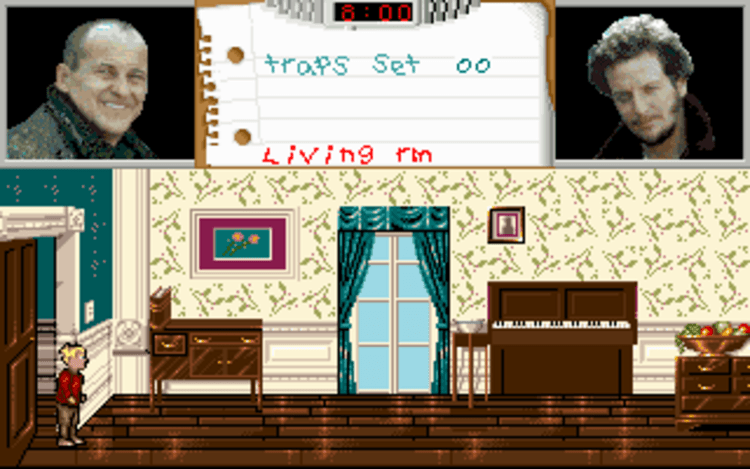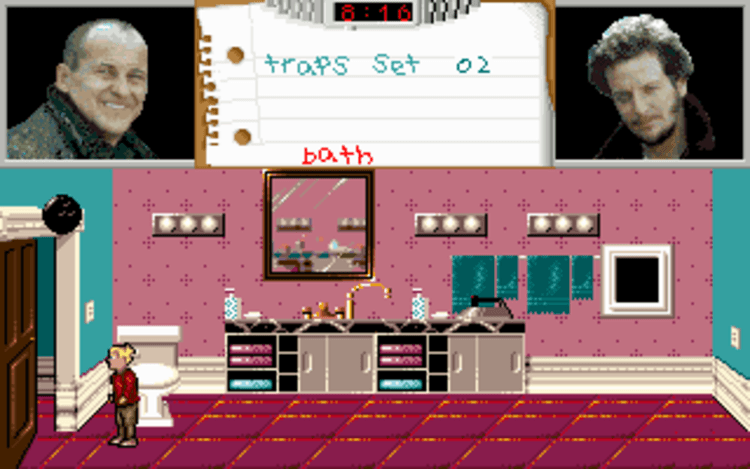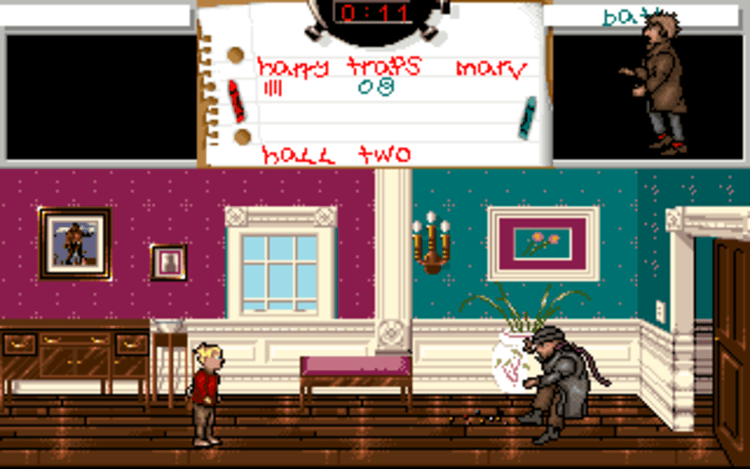
Home Alone is a classic DOS action game published by Capstone that lets you step into Kevin’s sneakers and defend the family house from two persistent burglars. Players race against the clock to place traps, gather gadgets and turn everyday objects into mischievous weapons. The frantic, trap-focused gameplay feels like a mix between platform and strategy titles, similar in spirit to movie-based games like Die Hard or The Addams Family. Whether you play Home Alone online or on original hardware, it delivers a playful blend of slapstick chaos and quick-thinking defense.
Home Alone for DOS takes the beloved movie premise of a kid left to guard his house and turns it into a fast-paced action game full of slapstick danger. Published by Capstone and developed for home computers of the era, it captures the energy of the film while adding layers of interactive challenge. Instead of simply watching Kevin trick the burglars, you are the one racing around the house, lining up painful surprises and trying to survive a night of break-in attempts. The result is a nostalgic experience that blends classic arcade concepts with a charming, story-driven setting.
At its core, the Home Alone DOS game is about improvisation and timing. You explore the family home, gather items and decide where each trap will have the most impact. The game invites you to know the layout of the house, anticipate enemy movements and react under pressure as the burglars close in. This creates a unique tension, somewhere between a strategic defense game and an action-heavy platformer. Fans of early nineties tie-in titles will recognize that mix of licensed storytelling and arcade-style gameplay that made so many movie games memorable.
When you play Home Alone, the first thing you notice is the emphasis on movement and planning. Kevin can run through different rooms, climb stairs and access key areas like the attic, basement and corridors where the burglars are most likely to appear. Scattered throughout the house are objects that can be turned into traps, from toy cars and paint cans to more imaginative hazards that fit the tone of the film. Choosing what to place and where is the heart of the gameplay loop.
The burglars, echoing the movie’s clumsy duo, march into the house with determined but predictable patterns. They are not invincible, but they are persistent, and their slow but steady advance forces you to think ahead. Each trap you place has a visual and mechanical payoff: the burglars slip, fall or get stunned long enough for you to regroup and re-arm the home. The sense of satisfaction when a carefully placed trap chain works perfectly is one of the game’s biggest rewards, and it keeps players experimenting with new setups and routes.
While the visuals are shaped by the limitations of DOS-era graphics, they use color and animation to convey personality. Kevin’s sprite is expressive, the burglars have exaggerated reactions, and the rooms are distinct enough that you quickly learn them by sight. The sound effects reinforce the slapstick humor, accentuating every mishap with satisfying crashes and thuds. Together, these elements create a cartoonish atmosphere that stays true to the spirit of the film without relying solely on cutscenes or dialogue.
Beneath its comedic surface, the Home Alone game offers surprising depth. The time pressure means you cannot casually stroll around; you must prioritize key choke points, secure paths, and anticipate where the burglars will strike next. Players who enjoy strategy will study the house layout, memorizing entry points and optimal spots for high-impact traps. This transforms each playthrough into a kind of puzzle, where the goal is not just to survive, but to do so efficiently, stylishly and with minimal mistakes.
Difficulty can vary depending on how aggressively you plan and how familiar you are with the burglars’ behavior. New players may feel overwhelmed as they scramble around the house trying to cover every angle, while more experienced players will learn to funnel the burglars into danger zones. This gives the game a form of replay value: even though the basic story remains the same, you can refine your tactics, experiment with different trap combinations and aim for smoother, cleaner runs.
The game also stands out as a family-friendly action experience. There is conflict and peril, but it is framed as exaggerated comedy rather than harsh violence. That makes Home Alone suitable for a wide range of players, from nostalgic adults revisiting a childhood favorite to younger players discovering classic DOS games for the first time. The appeal lies in creativity, timing and humor rather than direct confrontation.
Modern players can easily revisit this classic by choosing to play Home Alone online, enjoying the game directly in a browser without needing to configure old hardware. Running the Home Alone game through browser-based emulation keeps the original look and feel while making it accessible on a wide range of devices. Because it can be played for free and streamed rather than installed in a traditional way, jumping into a quick session of trap-setting chaos becomes effortless.
One of the great advantages of playing Home Alone online is that it works smoothly on both desktop and mobile devices. The simple control scheme and relatively compact display adapt well to different screen sizes, so defending the house feels natural whether you are using a keyboard, a physical controller or touch controls mapped to on-screen buttons. This flexibility makes it easy to share the experience with friends and family, turning a single-player challenge into a social nostalgia trip.
The timeless premise of protecting the house from burglars and the modest system demands of a DOS game make Home Alone an ideal candidate for online play. You can dip into short sessions during a break or settle in for repeated attempts as you refine your defensive strategies. Because the rules are straightforward and the objectives are clear, anyone can quickly understand how to play, yet mastering trap placement and movement timing keeps the game engaging over the long term.
For fans of classic DOS titles, Home Alone represents a snapshot of an era when movie-based games were expected to translate a cinematic story into interactive challenges. Some adaptations of that time leaned too heavily on the license without delivering satisfying gameplay, but Home Alone manages to balance recognizable story elements with a distinct, playful identity. The focus on traps and environmental interaction makes it feel different from more straightforward action-platformers.
The game also serves as an accessible introduction to the broader world of retro PC gaming. Its controls are simple, its goals are easy to grasp and its tone is light-hearted. Players who might be intimidated by complex role-playing systems or deep simulations can find in Home Alone a comfortable starting point. At the same time, experienced players can appreciate the way it uses limited resources to build tension, humor and variety within the confines of a single house under siege.
As a piece of interactive nostalgia, Home Alone shows how a familiar story can be reimagined through gameplay. Instead of passively watching Kevin’s antics, you become the mastermind behind every prank and mishap. That shift from viewer to participant is what makes classic game adaptations enduring for fans of both cinema and retro gaming.
All used codes for this game are publicly available, and the game itself belongs entirely to its original authors and rights holders.
Share game
Share game







Share game